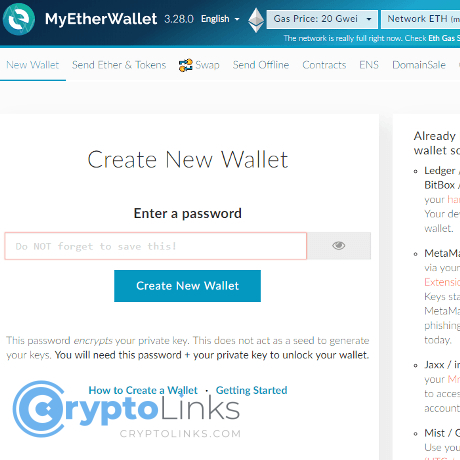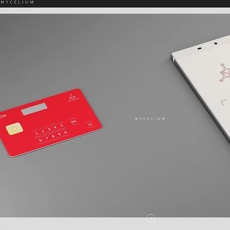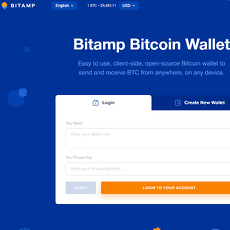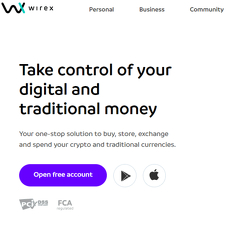My Ether Wallet Review
My Ether Wallet
www.myetherwallet.com
My Ether Wallet (MEW) Review Guide: Why Picking the Right Ethereum Wallet Could Save Your Crypto (and Sanity)
Ever worry about your Ethereum or crypto tokens suddenly vanishing, or worse, being locked out of your own wallet? You’re definitely not the only one! Every day, people face sleepless nights just because the right (or wrong) wallet decision made all the difference. So, let’s get real about how you actually protect your crypto—and why so many people are talking about My Ether Wallet (MEW).
Why Picking the Right Ethereum Wallet Matters
Crypto Hacks, Confusing Choices, and Sleepless Nights
Let’s be honest: Choosing a crypto wallet isn’t just about cool features or design. It’s about protecting your money. Here’s the scary truth—every single day, thousands of dollars are lost because of:
- Phishing attacks: Simple mistakes, like clicking a fake MEW link you spotted on Google, have cost people their entire savings.
- Confusing wallet types: With names like hardware, mobile, browser extension, and “self-custody,” it’s ridiculously easy to feel lost and pick something that doesn’t fit your needs—or worse, that’s a scam.
- Human errors: Ever misplaced a password? Now imagine losing a long string of random words instead. Not fun.
In fact, a 2023 report from Cybersecurity Ventures found that crypto theft and hacks grew by nearly 50% last year alone. And, most cases start with someone choosing the wrong wallet or falling for a fake version.
What This Guide Delivers
I’m here to walk you through everything about My Ether Wallet. No tech jargon, just the basics you really care about:
- Is MEW actually safe?
- How does MEW work in the real world (not just on a pretty landing page)?
- What are users saying right now—both the good and the frustrating?
- What changes have been made lately?
If you want no-nonsense answers, practical advice, and honest info—this is the place to get it.
Who Will Benefit Most From This Review?
This review is laser-focused for:
- Beginners who want a first wallet, but are unsure about private keys or seed phrases.
- Seasoned crypto traders or NFT collectors looking for flexibility, especially on Ethereum.
- Long-term holders thinking about security and whether to trust MEW for the big stacks.
If you’ve ever found yourself Googling “best Ethereum wallet” at 2am, this guide has your back.
Still with me? You might be wondering, “But what actually is a crypto wallet, and do you absolutely need one to get started?” Stick around—next, I’ll break down exactly why wallets matter, how they work, and where MEW fits into the whole picture.
The Big Picture: Crypto Wallets 101
You might be wondering, “Why bother with a crypto wallet at all? Can’t I just leave my coins somewhere safe and easy, like on an exchange?” If only it were that simple. Ask anyone who's been through a major crypto hack or lost access to a trading platform—trust is earned, not given, and control is everything.
“If you don’t own your keys, you don’t own your coins.”
That old saying is legendary for a reason. Wallets aren’t just storage—they’re your ticket to true ownership.
Why Do You Even Need a Crypto Wallet?
First things first: you need a wallet because you want to be in control. Exchanges can freeze assets, get hacked, or simply vanish (yes, that really happens). A real wallet means your crypto actually belongs to you, not a third party.
- Security — Your keys are yours. There’s no customer support “just in case” with most platforms.
- Privacy — Wallets help keep your transactions away from prying eyes. If you care about your anonymity, it’s non-negotiable.
- Freedom — Pay or get paid whenever, wherever. No banking hours, no middlemen.
If you’ve ever seen people heartbroken over lost funds (think: Mt. Gox, FTX), you know that without a secure wallet, your assets aren’t truly yours. No one wants to lose sleep over whether their crypto will still be there tomorrow.
Types of Crypto Wallets Out There
Now, let’s break it down. Not all wallets are created equal, and each kind is suited to different needs and personalities:
- Software Wallets — This is the most popular pick. They come as web, desktop, or mobile apps. Super convenient and fast for everyday use, but you need to watch for phishing attacks and malware.
- Hardware Wallets — Actual physical devices that keep your keys offline (Trezor and Ledger are classics). Think of them as your digital vault. They’re super safe, but not as handy for small, frequent transactions.
- Paper Wallets — Yep, an old-school printed piece of paper with your keys. Virtually hack-proof...if you don’t lose it, spill coffee on it, or let your dog use it as a chew toy.
Each type is about balancing convenience with security. In a Statista survey, over 45% of crypto users picked software wallets for their day-to-day. Why? You get flexibility, but you’ve got to stay sharp.
Where My Ether Wallet Fits In
So where does My Ether Wallet (MEW) fit into this puzzle? MEW is a software wallet—specifically, a web-based wallet designed to interact directly with the Ethereum blockchain.
What’s cool about this? You don’t need to install a thing; just open your browser, create or access your ETH wallet, and off you go. It’s built for Ethereum and all its tokens (think ERC20, NFTs, and more), giving you serious flexibility without relying on any one company to “hold” your coins.
- No downloads needed—your keys stay with you
- Great if you’re into DeFi, NFTs, or swapping tokens
- More user-friendly than old-school paper wallets, but less iron-clad than hardware wallets
If you’ve been burned by clunky software or confusing apps in the past, MEW’s approachable vibe is a breath of fresh air. But is it really the best choice for your ETH and tokens? That’s what I’ll dig into next—trust me, you don’t want to miss the real story behind what makes MEW tick (and where it sometimes falls short). Ever wondered why MEW always pops up in top wallet roundups? Hang on, we’re about to get into the good stuff next.
Getting to Know My Ether Wallet (MEW)
What Is My Ether Wallet?
Let’s break it down simply: My Ether Wallet (often called MEW) is a free, open-source interface that lets you interact directly with the Ethereum blockchain. Imagine having a secure, user-friendly portal that lets you create wallets, send and receive ETH, manage tokens, and even connect with hardware wallets—all without handing your private keys over to anyone else. That’s what MEW set out to do when it launched back in 2015, and it’s why it exploded in popularity.
What’s unique here? You’re always in control. MEW never stores your private info or wallet data. You generate and protect your wallet—meaning, if you get this right (and I’ll show you how), nobody can take your assets away from you. That’s a big deal in crypto.
“My Ether Wallet gave me the freedom to manage my ETH, but more than that—it taught me to actually understand my wallet, not just use it.”
Some folks even call MEW the “Swiss Army knife” for Ethereum because it lets you do way more than just store coins. Whether you want to stake ETH, swap tokens, mint your first NFT, or just check a token balance in real-time, MEW has you covered.
Supported Assets: Can You Only Store ETH?
If you’re thinking, “Is MEW just for Ethereum?”—here’s the real picture:
- ETH: Of course, it’s the bread and butter. You can send, receive, and manage Ether easily.
- ERC-20 Tokens: MEW shines here. Any token built on Ethereum’s ERC-20 standard (think USD Coin, Shiba Inu, Chainlink, and thousands of others) is fully compatible. If you’re a DeFi enthusiast, this matters.
- ERC-721 NFTs: You can manage your NFTs (like the ones you own from OpenSea) straight from MEW. Want to see your art or collectibles? Their mobile app and web tools display your assets cleanly.
MEW helps you manage an entire Ethereum-based portfolio, whether you’re stacking altcoins, farming yield tokens, or just holding a quirky NFT profile photo. No wonder it’s been the first wallet for millions.
How MEW Compares to Other Wallets
Now for the hot topic: how does MEW actually stack up against other wallets—like the hardware beasts (Ledger, Trezor), MetaMask, or even mobile-only apps?
- MEW vs Hardware Wallets: Security lovers, listen up—hardware wallets physically isolate your private keys, making hacks much harder. But here’s the thing: MEW integrates flawlessly with hardware wallets. So, you get the best of both worlds: seamless web interface + physical security (no extra hoops to jump through).
- MEW vs MetaMask: MetaMask is a browser extension—and while it’s super popular, it stores encrypted wallet info in your browser itself. MEW’s web interface doesn’t do that unless you explicitly choose to. Plus, MEW offers direct hardware wallet support, and in my experience, its web experience feels less cluttered for new users. Want to stake, mint NFTs, or swap tokens? Both can do it, but MEW lays it out with fewer pop-ups and a more “choose your own adventure” feeling.
- MEW vs Mobile Wallets: If you want to manage crypto on the go, MEW’s mobile app is slick, showing NFTs and tokens in one place (a known pain point with other mobile wallets). You can even connect the mobile app to a hardware wallet, which isn’t always possible elsewhere.
Don’t just take it from me—there’s a reason MEW consistently lands on top wallet lists and shows up in user surveys. For those wanting real flexibility plus solid security options, it holds its ground against every major competitor.
If you’re starting to picture managing your assets in MEW, you’ll want to know just how easy or tricky it is to set up, keep secure, and actually use day-to-day. Wondering what’s involved in creating your first Ethereum wallet and what mistakes to absolutely avoid? Stick around, because the next section is going to show you, step-by-step, how to make MEW work for you—without any rookie mistakes.
Setting Up and Using My Ether Wallet
Ready to roll up your sleeves? This is the hands-on part, and honestly, it’s the one most users stress about. If you’ve ever hesitated with setting up a crypto wallet because of all the horror stories about lost keys and clunky interfaces… you’re definitely not alone.
“A small leak will sink a great ship.”
That one’s as true for Ethereum wallets as it was for Benjamin Franklin’s boat. Let’s make sure you secure your MEW wallet from the outset!
How to Create a MEW Wallet (Step by Step)
Starting fresh? Here’s what you actually need to do—no jargon, just real talk.
- Go to myetherwallet.com. Double-check the URL. Fake sites are everywhere—don’t fall for them!
- Click “Create New Wallet.” The latest version of MEW makes this surprisingly simple.
- Generate your wallet—MEW offers several methods, but the most common is the strong password + keystore file option, or using a secure hardware device.
- Save your secret recovery phrase (sometimes called a seed phrase) offline. MEW will show you 12 or 24 words—write these down on paper, store them somewhere safe, and never, ever on your phone or cloud.
- Download your keystore file (and maybe print your public address QR code if you’re old school).
- Your account is live! But… you’re not done. Take a moment to back up your data, check your phrase for accuracy, and create a test transaction if you want total peace of mind.
Real talk? According to studies by Ledger, nearly 15% of crypto losses happen due to lost or badly stored recovery phrases. It’s the number one reason newbies lose funds—so please don’t skip this step.
Accessing Your Wallet: Web, Mobile, Hardware
One reason folks love MEW is the flexibility. Maybe you’re on your laptop. Or maybe you just want a quick ETH check on your phone. MEW has you covered.
- Web Version: The classic. Super easy to use with MetaMask, keystore files, or even hardware wallets.
- Mobile App: Grab MEW’s official app on Android or iOS—this isn’t just a “light” wallet, it’s a full-featured toolkit. Scan QR codes, use biometric login, and manage tokens securely wherever you are.
- Hardware Wallets: Ledger and Trezor integration is seamless. You connect via USB or Bluetooth (for Ledger Nano X), and none of your keys ever touch the internet. If you’re planning to store a serious chunk of ETH, this is how the pros do it (and yes, it’s worth the extra 30 seconds at login).
The best part? You can bounce between devices. Maybe you check balances on mobile but send bigger transactions with your hardware wallet. MEW makes it frictionless.
Sending, Receiving, and Managing Assets
Let’s talk about actual day-to-day use. With MEW, managing your crypto isn't rocket science:
- To receive coins or tokens: Grab your public address (looks like 0x…) and share it—no one can steal your funds with just that. You can even set up a QR code.
- To send ETH or tokens: Paste the recipient’s address, pick the asset, double-check the amount (seriously, triple check on large amounts), and confirm. MEW lets you adjust gas fees depending on how fast you need the transaction.
- Token management: MEW detects most ERC20 tokens automatically. If you’re dealing with something obscure, you can manually add the contract address and see it pop up instantly.
- Taxes & activity: MEW shows your transaction history right inside the wallet. For U.S. users and others who need to report crypto gains, you can even export your transaction logs—super handy come tax season.
- Popular extras: MEW connects with swaps, DeFi, and staking (depending on your region). Want to earn interest or move tokens to DeFi protocols like Aave? You’re only a couple clicks away—all from the same dashboard.
Honestly, once you get the hang of it, MEW feels like second nature. But here’s the thing… with power comes responsibility. You’re the only one who controls your keys—and that means you need to be thinking about security with every action.
If you’re anything like most users, your next question is probably: “But just how safe is it—really?” Don’t worry, that’s coming up next. Want to know what MEW does (and what you still need to do) to keep your funds protected? Keep reading—you’re about to find out the security secrets I wish every beginner knew before they took the leap.
MEW Security: Protecting Your Funds
Let’s talk about the part that keeps most people up at night—security. There’s nothing quite like checking your crypto and realizing the funds are safe (or, in the worst case, gone). Here’s the truth: in crypto, you are your own bank, and with My Ether Wallet, the responsibility gets real. But is it secure enough to put your hard-earned ETH on the line?
Is My Ether Wallet Safe?
This is the big question. MEW is built around self-custody, which means you control your private keys—nobody else. The wallet never stores your data or private details on any server. When you interact with the MEW interface, everything you do happens locally on your device. That’s a big plus for privacy.
What about actual features?
- Self-custody: Only you have access to your wallet keys, unlike on an exchange where hacks can wipe out everyone’s balance at once.
- Encryption: Private keys are encrypted and can be stored offline, especially if you use MEW with a hardware wallet like Ledger or Trezor.
- Phishing protection: MEW runs ongoing warnings about fake websites and sneaky clones. They even publish lists of flagged domains to help you avoid common scams.
I’ve seen actual cases—especially during 2017’s ICO boom—where copycat sites snatched private keys within minutes. According to a 2021 CipherTrace crypto crime report, phishing attacks are still among the top causes for wallet losses in the Ethereum ecosystem. One click on a fraudulent link and you’re toast.
"Crypto doesn’t forgive. If you get phished, there’s no bank hotline to call. That feeling of checking for your funds—hold onto it."
Best Practices for Maximum Safety
If you don’t want to end up in those ‘I lost everything’ Reddit threads, here are the absolute non-negotiables. (I’ve helped enough readers to know that these aren’t optional—this is survival.)
- Never share your private key or recovery phrase, not even for “support” reasons. No legit service will ever ask.
- Use hardware wallets whenever possible. Pairing MEW with something like Ledger or Trezor means your keys never even touch your computer.
- Bookmark the official MEW site. Typing the address can lead to typos and scams. Always check for the lock icon and “https://” in your browser.
- Enable 2FA if you use the MEW mobile app or connect MEW with platforms that support two-factor authentication.
- Keep backups of your keys— write them down and keep them safe, not just on your phone or computer.
- Avoid public WiFi for any transactions. Always check your environment before logging in.
Even veterans get caught by something as simple as downloading a fake browser extension or using an outdated site version. Double-check everything. “Measure twice, send once.”
How Does MEW Handle Lost Access?
Here’s another nerve-wracking scenario: What if you forget your password, lose your device, or accidentally wipe your computer?
- If you saved your recovery phrase (seed phrase), you’re good. MEW lets you restore your wallet from this phrase on any new device or MEW-compatible wallet.
- If you only have your private key, you can unlock the wallet but you’ll need that exact file or string. No key, no access.
- Lost both? This is harsh but true: There’s no way back. MEW is non-custodial, so there's no password reset button or recovery hotline. This is why their onboarding process has “write this down!” warnings everywhere.
If you ever spot odd activity or think your data is compromised, move your funds immediately to a new, untouched wallet. Time is everything in crypto security.
Security evolves fast, but so do the threats. That’s why the changes and new features matter—a lot. Wondering how MEW is leveling up its defenses and what new tools or features have rolled out lately? You’re about to find out (and you’ll want to see what’s changed, especially if you haven’t checked MEW in a while)...
Recent Updates and What’s New With MEW
Crypto never sleeps—and neither should your wallet. One thing I’ve noticed is that staying on top in this industry means non-stop updates, tweaks, and new features. My Ether Wallet (MEW) absolutely gets this, and that’s clear when you see what they’ve rolled out recently. So, if you’re someone who wants the latest tech under the hood, here's what you should know.
New Features Rolled Out in the Last Year
MEW has stepped up in ways I didn’t see coming a year ago. If you haven’t checked in on them lately, here’s a taste of what’s fresh:
- Mobile App Upgrades: The MEW mobile app now feels almost like having a Swiss Army knife for Ethereum in your pocket. They've added streamlined wallet creation, support for NFTs, built-in staking, and a sleek DApp browser—that means yes, you can browse DeFi and NFT dapps directly from your phone. As an example, I tested sending an NFT to a friend and it took just a few taps—no tech headaches, no dramas.
- Native NFT Support: This wasn’t always the case, but now you can view, send, and manage your ERC721 and ERC1155 NFTs right from the interface. That’s a game-changer if, like me, you’re tired of switching between apps to manage collectibles. A recent survey by NonFungible.com showed NFT support topped the wishlist for Ethereum wallet users—so it’s great to see MEW listening.
- Enhanced Hardware Support: MEW’s partnerships with Ledger and Trezor are tighter than ever. The integration is smoother, plus you can access advanced contract functions. No more clunky workarounds—finally, things just work.
- Improved User Protection: With all the recent phishing attacks in the news, MEW’s extra anti-phishing warnings and scam-detection banners feel reassuring. As someone who’s seen phishing up close in the wild, I’m honestly grateful for these safety nets.
- Gas Fee Estimators: MEW now offers real-time and predictive gas fee suggestions (with historical data). Sending ETH or tokens isn’t a guessing game anymore—just a few clicks, and you see suggested fast, average, or cheap rates. According to Consensys Labs, wallets with gas estimators have cut user fee overpayments by up to 37%.
"The secret of change is to focus all your energy, not on fighting the old, but on building the new." — Socrates
How Often Is MEW Updated?
Here’s something every crypto user should care about: how engaged is the team? MEW doesn’t rest on its reputation. New versions and features drop regularly—sometimes monthly, often in response to real-time threats or feedback from the community. Just jump on their GitHub or peek at their Twitter, and you’ll see: updates are a way of life.
This matters. Crypto changes fast (remember the last time the Ethereum network updated and half the wallets lagged behind?). MEW’s pace gives me confidence—they don't just keep up, they stay ahead. They rolled out support for Ethereum upgrades within days, not weeks, of release.
The result? I feel safer trying new things—staking, NFTs, multi-chain swaps—because MEW supports what's current, and you don’t get left with an outdated wallet. Nothing worse than missing out just because your wallet didn’t catch up, right?
But speaking of “feel,” I’d love to share how real users experience these changes—are these updates truly making MEW a joy to use, or are there hidden headaches you should know about? Trust me, you’ll want to see what everyday holders and power users really think...
Have you ever explored wallet updates that made things worse, not better? There’s a story coming up you won’t want to miss…
Real User Experience: Pros, Cons, and Common Complaints
The Good: What Users Like
If you ask around, you'll hear a lot of users call My Ether Wallet their "Swiss Army knife" for Ethereum—flexible, reliable, and jam-packed with handy features. There’s a reason MEW has stuck around from the early days of Ethereum to now.
- Easy interface: A lot of people praise MEW’s clean, no-nonsense layout. Even if you’re not a developer, you can generate a wallet or send tokens without pulling your hair out. It’s not flashy, but it gets the job done.
- Compatibility: MEW plays nice with just about everything—Ledger, Trezor, MetaMask, and its own mobile app. If you’re security-focused, you can use a hardware wallet. On the go? Just switch to mobile.
- Feature-packed, but not bloated: From staking to NFT management, MEW keeps adding tools. I’ve seen seasoned ETH holders who still use MEW as their “all-in-one” dashboard.
- No KYC headaches: You don’t have to hand over your documents, selfies, or fingerprints—privacy fans love this.
“Once you get used to MEW, it’s tough to switch. Everything just works, and I feel in control of my ETH.” — a Reddit user, r/ethereum
The Challenges: What Users Dislike
Even the best tools have their hiccups, and MEW is no exception. Here’s what tends to trip people up:
- Security is a double-edged sword: You’re in charge of your private keys—period. That’s empowering, but if you lose them, there’s no safety net. Some users have lost funds simply because they didn't back up their seed phrase. That pain is real.
- Phishing risks: I’d be rich if I had a dollar for every new scam site pretending to be MEW. Fake links in Google ads or slightly misspelled URLs have caught people off guard, leading to heartbreak. Chrome browser privacy reports actually flagged “myetherwallet” phishing clones as a top crypto scam search term in 2023!
- Some say the design is outdated: MEW’s look is functional, but it’s not winning any beauty contests. A few newer users wish it felt more “modern app” and less “old-school website.”
- Confusion over supported tokens: With so many ERC tokens out there, some assets don’t always show up automatically, and adding them can feel fiddly. This often pops up during big NFT drops or when new tokens launch.
Customer Support and Community
This is where things get interesting. MEW’s team is pretty active on Twitter and Reddit, and there’s a solid knowledge base and help desk on their site. But, like most crypto wallets that don’t run on user accounts, direct in-app support is limited.
- Fast on social media: When big bugs hit—like the 2022 Ledger connectivity snafu—MEW’s Twitter was on fire, helping users get back online quickly.
- Helpful community: Forums like r/etherwallet are full of fellow users offering advice (sometimes faster than official support).
- Email response time: You’ll get a reply, but don’t expect instant chat-level speed. Most questions get sorted within a day or two, based on what users report.
If you’re someone who likes lots of hand-holding, you might find the decentralized, self-service style a little challenging at first. But the crowd-sourced guidance is usually spot-on, and you’ll find detailed walkthroughs or videos for just about any issue that pops up.
All in all, using MEW can be a bit like owning a classic car—you get all the raw power and control, but you’ve got to pay attention and handle it with care. Are you comfortable keeping track of your own keys, or do you want something with a big support safety net?
Up next, I’ll explore how to actually match a crypto wallet—like MEW—to your portfolio and style. Curious whether MEW fits you, or if there’s something even better out there? You might be surprised by what’s coming next…
Is MEW Right for You? Factors to Consider
Choosing a crypto wallet is a big decision. It can make the difference between sleeping easy at night and endlessly worrying your coins aren’t safe. So, is MyEtherWallet the match for you and your crypto plans? Let’s break it down based on what I’ve seen, tested, and what real users (plus a few studies) say about picking an Ethereum wallet.
Your Crypto Portfolio: Is MEW a Fit?
If you’re mainly into Ethereum and ERC20/ERC721 tokens, MEW often tops the list. For collectors trading NFTs or holding a mix of DeFi tokens, MEW covers the basics nicely. I’ve talked to traders who swear by its simple interface when swapping tokens or interacting with smart contracts. But if you’re holding Bitcoin, Solana, or the newer Layer 1 coins, you’ll need another wallet or have separate setups, because MEW really shines in the Ethereum space—nothing beyond it.
- MEW is great for: ETH, DeFi users, NFT holders, and folks who experiment with Ethereum dApps.
- Not ideal for: People who want multi-coin support including Bitcoin, or who trade on non-Ethereum networks daily.
Fun fact: According to a 2023 survey by Chainalysis, users with portfolios limited to Ethereum portfolios reported fewer wallet-switching hiccups and less confusion overall. It pays to pick your tools based on what coins you actually hold!
Security, Ease of Use, and Backup
Let’s be honest, everyone has a different appetite for risk. If you’re new and worried about losing keys or falling for scams, MEW’s compatibility with hardware wallets (like Ledger and Trezor) can be a lifesaver. Plug in your hardware device and use MEW as a gateway—no private keys ever touch your computer.
- Beginners: MEW’s step-by-step onboarding takes off a lot of pressure. If you’re security-conscious, start with hardware wallet integration right away or use strong offline backups (write down your phrase; don’t screenshot it—seriously).
- Veterans: Advanced settings let you interact with custom networks, sign messages, or stake assets. Some power users say using MEW with cold storage is their go-to method for DeFi and NFT activity.
- Mobile-first? MEW also offers a mobile app—good if you’re always on the move, but remember, mobile wallets can be lost with your phone, so always backup.
Real talk: Security best practices are non-negotiable. Even the most user-friendly wallet can’t save you if your private key winds up in the wrong hands. Never store them in email or cloud services—every year, hacks prove why that’s a recipe for disaster.
Resources for Further Wallet Research
Want to go deeper before you commit? I always recommend doing your own homework. Here are a few handpicked resources packed with wallet comparisons, up-to-date security tips, and honest takes on popular choices:
- Best Cryptocurrency Wallets Guide — See 36 top wallets, ranked and reviewed for all kinds of use cases.
- Best Bitcoin Wallets List — Explore both hardware and software picks if you’re getting into more than Ethereum.
- Crypto Wallet Security Best Practices — Tips that every holder (rookie or pro) should follow.
Cryptocurrency is slowly establishing itself as a global phenomenon, especially now that it has become fashionable to own one … And judging by the number of options available today, and the relentless cases of crypto thefts, it is imperative to do extensive research before making a choice … Read through our review on each before reaching a decision.
The crypto wallet you pick should work for your lifestyle—not the other way around. I’ve pulled together everything to help you find your match, but there’s still another question many people ask before hitting “Create Wallet”: What if you lose your private key, want to buy crypto directly, or need support fast?
I’ll get to all that—and more—in the next section. Ready to find out if MEW can really handle the pressure when it matters most? Hang tight, because your answers are up next.
Frequently Asked Questions + Final Thoughts
FAQ: Quick Answers to Hot Questions
- What is My Ether Wallet (MEW)?
It’s a free, open-source tool for creating and managing Ethereum wallets. MEW lets you control your own ETH and tokens—no third party ever takes custody of your crypto.
- Is MEW a wallet or an exchange?
Mostly a wallet, but with some exchange features. You can store, send, and manage ETH/ERC20/ERC721 assets. And thanks to integrations, you can swap or buy tokens right inside the wallet—just note that MEW links you to third-party services for those actions.
- Can I buy crypto through MEW?
Yes. Through partnerships with crypto-buying providers (like Simplex and MoonPay), you can purchase ETH using a credit card or bank transfer. The process is built in, but again, it’s powered by third parties—not MEW itself.
- Can you recover access if you lose your private key or recovery phrase?
No. If you lose your MEW private key or recovery phrase, there’s no way to reset or recover it—period. This isn’t just MEW’s rule; it’s how self-custody wallets work in general. If you haven’t already, back up your phrase and store it somewhere ultra-safe.
- Is MEW safe?
Yes, as long as you follow good security practices. MEW never actually stores your keys—they’re on your device/browser or hardware wallet. But phishing sites and careless downloads can still get you. Always triple-check URLs and never share your private info.
Other Handy Tips Before You Use MEW
New to MEW or crypto wallets? Even the most experienced users sometimes slip up with security, so here’s a checklist I always follow myself. Trust me, these are small steps that make a huge difference:
- Bookmark the official MEW site: Always use https://www.myetherwallet.com/. Phishing scams are constantly floating around with similar URLs.
- Create offline backups: Write your recovery phrase on actual paper (yes, old school!) and tuck it away somewhere impossible for prying eyes to find.
- Test with small amounts first: When sending or receiving, use a small sum before you go all in—especially if it’s your first time. Peace of mind is worth the extra step.
- Hardware wallet = best friend: If you hold any serious amount of ETH or NFTs, consider pairing MEW with a hardware wallet. It’s one of the safest combos out there.
- Keep your devices clean: Always use updated antivirus software, and only interact with MEW from devices you trust.
Security might sound like a boring chore, but it’s what separates a clever crypto user from the one who gets “rekt.”
Wrapping Up: Is MEW Worth It? (My Honest Opinion)
Here’s the deal. My Ether Wallet stays relevant for a reason: It’s a no-nonsense, highly flexible wallet that gives you total control of your Ethereum-based assets. It’s not as slick as some of the newer mobile-first wallets, and it’s not for those looking for the hand-holding you’d get at a big exchange. But if you want open-source, trustless access to Ethereum, this is one of the most battle-tested options out there.
Pick MEW if:
- You want to manage your own keys (and understand the responsibility that comes with it).
- You hold mainly ETH or Ethereum tokens (ERC20, NFTs, etc.).
- You like having the power to do swaps, DeFi, and NFT management without relying on one single app or provider.
Skip MEW if you’re looking for multi-chain support or want a super-simple “sign up and go” style experience—there are better options for absolute beginners or multi-crypto holders, and you can find those in our main crypto wallet reviews section.
Bottom line: MEW is still a great choice if you’re focused on Ethereum, know the basics of wallet security, and want real control—not just convenience.
If you want to compare MEW with hardware wallets, browser-based alternatives, or all-in-one apps, head over to the full wallet list on Cryptolinks.com. I keep those guides fresh and packed with practical insights, so you can make the best choice for your crypto journey—no guesswork, no fluff.













